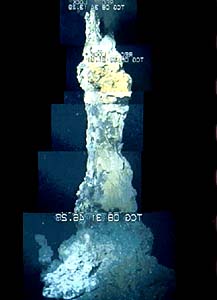| . |  |
. |
 Surviving Deep Pressure
Surviving Deep Pressureby Jon Copley Walla Walla - December 9, 1999 - The secret of deep-sea living is a molecule that helps proteins keep their shape under the crushing pressures of the depths, marine biologists have found. The same chemical may be able to salvage proteins damaged in diseases such as cystic fibrosis. Deep-sea creatures endure pressures several hundred times greater than that at the surface. The high pressures can prevent proteins from folding up to form working enzymes, according to Paul Yancey of Whitman College in Walla Walla, Washington. Unfolded proteins are covered with water molecules, but for the protein molecule to fold up properly this water has to leave. "High pressure tends to trap water molecules on proteins," he says. Yancey has found that deep-sea animals--from fish to shrimp and anemones--contain much more of a compound called trimethylamine oxide (TMAO) than their shallow-living relatives. Furthermore, the higher the pressure where an animal lives, the greater the concentration of TMAO in its tissues. Yancey teamed up with Joseph Siebenaller of Louisiana State University in Baton Rouge to find out if TMAO helps keep the animals' proteins in working order. They took the same enzyme from three species of scorpion fish living at different depths, and from a cow. Regardless of the source of the enzyme, adding TMAO increased the enzyme's ability to withstand high pressures and attack by another enzyme that breaks down proteins. As TMAO seems ubiquitous among deep-sea animals, it may be a good example of how different species home in on the same survival trick as they evolve. But its ability to stabilise a cow enzyme suggests that TMAO's protective power extends much further. In test-tube experiments, William Welch and Christopher Brown of the University of California at San Francisco have used TMAO to rescue misfolded proteins produced in cystic fibrosis. "Even though humans don't have TMAO, it seems to be a universal stabiliser," says Yancey. "The idea is that it could be used medically also to work on all sorts of proteins." Source: The Journal of Experimental Biology (vol 202, p 3597)
This article will appear in the December 11 issue of New Scientist New Scientist. Copyright 1999 - All rights reserved. The material on this page is provided by New Scientist and may not be published, broadcast, rewritten or redistributed without written authorization from New Scientist.
SPACE SCIENCE
|
| |||||||||
| The content herein, unless otherwise known to be public domain, are Copyright 1995-2016 - Space Media Network. All websites are published in Australia and are solely subject to Australian law and governed by Fair Use principals for news reporting and research purposes. AFP, UPI and IANS news wire stories are copyright Agence France-Presse, United Press International and Indo-Asia News Service. ESA news reports are copyright European Space Agency. All NASA sourced material is public domain. Additional copyrights may apply in whole or part to other bona fide parties. Advertising does not imply endorsement, agreement or approval of any opinions, statements or information provided by Space Media Network on any Web page published or hosted by Space Media Network. Privacy Statement All images and articles appearing on Space Media Network have been edited or digitally altered in some way. Any requests to remove copyright material will be acted upon in a timely and appropriate manner. Any attempt to extort money from Space Media Network will be ignored and reported to Australian Law Enforcement Agencies as a potential case of financial fraud involving the use of a telephonic carriage device or postal service. |